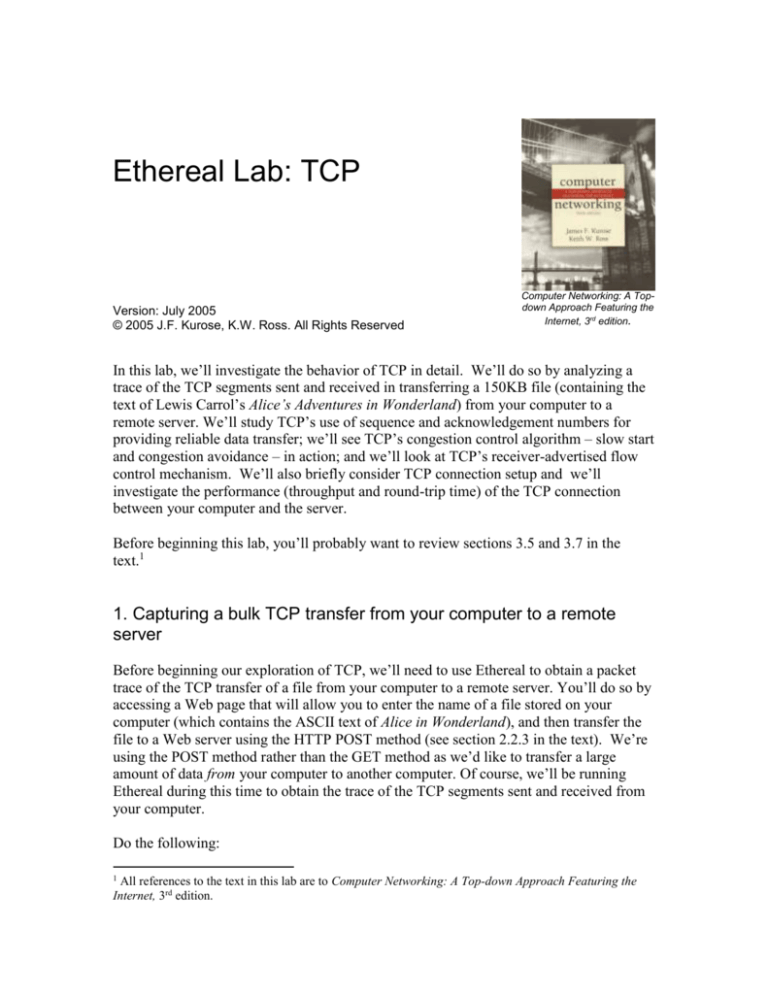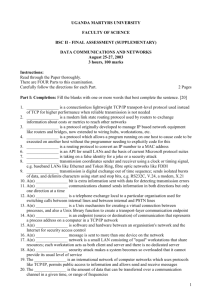
Ethereal Lab: TCP
Version: July 2005
© 2005 J.F. Kurose, K.W. Ross. All Rights Reserved
Computer Networking: A Topdown Approach Featuring the
Internet, 3rd edition.
In this lab, we’ll investigate the behavior of TCP in detail. We’ll do so by analyzing a
trace of the TCP segments sent and received in transferring a 150KB file (containing the
text of Lewis Carrol’s Alice’s Adventures in Wonderland) from your computer to a
remote server. We’ll study TCP’s use of sequence and acknowledgement numbers for
providing reliable data transfer; we’ll see TCP’s congestion control algorithm – slow start
and congestion avoidance – in action; and we’ll look at TCP’s receiver-advertised flow
control mechanism. We’ll also briefly consider TCP connection setup and we’ll
investigate the performance (throughput and round-trip time) of the TCP connection
between your computer and the server.
Before beginning this lab, you’ll probably want to review sections 3.5 and 3.7 in the
text.1
1. Capturing a bulk TCP transfer from your computer to a remote
server
Before beginning our exploration of TCP, we’ll need to use Ethereal to obtain a packet
trace of the TCP transfer of a file from your computer to a remote server. You’ll do so by
accessing a Web page that will allow you to enter the name of a file stored on your
computer (which contains the ASCII text of Alice in Wonderland), and then transfer the
file to a Web server using the HTTP POST method (see section 2.2.3 in the text). We’re
using the POST method rather than the GET method as we’d like to transfer a large
amount of data from your computer to another computer. Of course, we’ll be running
Ethereal during this time to obtain the trace of the TCP segments sent and received from
your computer.
Do the following:
1
All references to the text in this lab are to Computer Networking: A Top-down Approach Featuring the
Internet, 3rd edition.
Retrieve and ASCII copy of Alice in Wonderland at
http://gaia.cs.umass.edu/ethereal-labs/alice.txt . Store this file somewhere on your
computer.
Next go to http://gaia.cs.umass.edu/ethereal-labs/TCP-ethereal-file1.html.
You should see a screen that looks like:
Use the Browse button in this form to enter the name of the file (full path name)
on your computer containing Alice in Wonderland. Don’t yet press the “Upload
alice.txt file” button.
Now start packet capture with Ethereal.
Returning to your browser, press the “Upload alice.txt file” button to upload the
file to the gaia.cs.umass.edu server. Once the file has been uploaded, a short
congratulations message will be displayed in your browser window.
Stop Ethereal packet capture. Your Ethereal window should look similar to the
window shown below.
If you are unable to run Ethereal on a live network connection, you can download a
packet trace file that was captured while following the steps above on one of the author’s
computers2. You may well find it valuable to download this trace even if you’ve
captured your own trace and use it, as well as your own trace, when you explore the
questions below.
2. A first look at the captured trace
Before analyzing the behavior of the TCP connection in detail, let’s take a high level
view of the trace. First, filter the packets displayed in the Ethereal window by entering
“tcp” into the display filter specification window towards the top of the Ethereal window.
What you should see is series of TCP and HTTP messages between your computer and
gaia.cs.umass.edu. You should see the initial three-way handshake containing a SYN
message. You should see an HTTP POST message and a series of “HTTP Continuation”
messages being sent from your computer to gaia.cs.umass.edu. Recall from our
2
Download the zip file http://gaia.cs.umass.edu/ethereal-labs/ethereal-traces.zip and extract the file tcpethereal-trace-1. The traces in this zip file were collected by Ethereal running on one of the author’s
computers, while performing the steps indicated in the Ethereal lab. Once you have downloaded the trace,
you can load it into Ethereal and view the trace using the File pull down menu, choosing Open, and then
selecting the tcp-ethereal-trace-1 trace file.
discussion in the earlier HTTP Ethereal lab, that is no such thing as an HTTP
Continuation message – this is Ethereal’s way of indicating that there are multiple TCP
segments being used to carry a single HTTP message. You should also see TCP ACK
segments being returned from gaia.cs.umass.edu to your computer.
Whenever possible, when answering a question you should hand in a printout of the
packet(s) within the trace that you used to answer the question asked. Annotate the
printout to explain your answer. To print a packet, use File->Print, choose Selected
packet only, choose Packet summary line, and select the minimum amount of packet
detail that you need to answer the question.
Since this lab is about TCP rather than HTTP, let’s change Ethereal’s “listing of captured
packets” window so that it shows information about the TCP segments containing the
HTTP messages, rather than about the HTTP messages. To have Ethereal do this, select
Analyze->Enabled Protocols. Then uncheck the HTTP box and select OK. Also, in this
lab we would like to see TCP’s sequence numbers (and not the relative sequence numbers
that Ethereal may instead display). To see the sequence numbers, go to
Edit>Preferences>Protocols>IP and uncheck “relative sequence numbers”. You should
now see an Ethereal window that looks like:
This is what we’re looking for - a series of TCP segments sent between your computer
and gaia.cs.umass.edu. We will use the packet trace that you have captured (and/or the
packet trace tcp-ethereal-trace-1 in http://gaia.cs.umass.edu/ethereal-labs/etherealtraces.zip; see footnote 2) to study TCP behavior in the rest of this lab.
3. TCP Basics
Answer the following questions for the TCP segments:
1. What is the IP address and TCP port number used by your client computer
(source) to transfer the file to gaia.cs.umass.edu? What is the IP address and port
number used by gaia.cs.umass.edu to receive the file.
2. What is the sequence number of the TCP SYN segment that is used to initiate the
TCP connection between the client computer and gaia.cs.umass.edu? What is it
in the segment that identifies the segment as a SYN segment?
3. What is the sequence number of the SYNACK segment sent by gaia.cs.umass.edu
to the client computer in reply to the SYN? What is the value of the
ACKnowledgement field in the SYNACK segment? How did gaia.cs.umass.edu
determine that value? What is it in the segment that identifies the segment as a
SYNACK segment?
4. What is the sequence number of the TCP segment containing the HTTP POST
command? Note that in order to find the POST command, you’ll need to dig into
the packet content field at the bottom of the Ethereal window, looking for a
segment with a “POST” within its DATA field.
5. Consider the TCP segment containing the HTTP POST as the first segment in the
TCP connection. What are the sequence numbers of the first six segments in the
TCP connection (including the segment containing the HTTP POST)? At what
time was each segment sent? When was the ACK for each segment received?
Given the difference between when each TCP segment was sent, and when its
acknowledgement was received, what is the RTT value for each of the six
segments? What is the EstimatedRTT value (see page 237 in text) after the
receipt of each ACK? Assume that the value of the EstimatedRTT is equal to
the measured RTT for the first segment, and then is computed using the
EstimatedRTT equation on page 237 for all subsequent segments.
Note: Ethereal has a nice feature that allows you to plot the RTT for each
of the TCP segments sent. Select a TCP segment in the “listing of
captured packets” window that is being sent from the client to the
gaia.cs.umass.edu server. Then select: Statistics->TCP Stream Graph>Round Trip Time Graph.
6. What is the length of each of the first six TCP segments?3
3
The TCP segments in the tcp-ethereal-trace-1 trace file are all less that 1460 bytes. This is because the
computer on which the trace was gathered has an Ethernet card that limits the length of the maximum IP
packet to 1500 bytes (40 bytes of TCP/IP header data and 1460 bytes of TCP payload). This 1500 byte
value is the standard maximum length allowed by Ethernet. If your trace indicates a TCP length greater
than 1500 bytes, and your computer is using an Ethernet connection, then Ethereal is reporting the wrong
TCP segment length; it will likely also show only one large TCP segment rather than multiple smaller
segments. Your computer is indeed probably sending multiple smaller segments, as indicated by the ACKs
it receives. This inconsistency in report edsegment lengths is due to the interaction between the Ethernet
7. What is the minimum amount of available buffer space advertised at the received
for the entire trace? Does the lack of receiver buffer space ever throttle the
sender?
8. Are there any retransmitted segments in the trace file? What did you check for (in
the trace) in order to answer this question?
9. How much data does the receiver typically acknowledge in an ACK? Can you
identify cases where the receiver is ACKing every other received segment (see
Table 3.2 on page 245 in the text).
10. What is the throughput (bytes transferred per unit time) for the TCP connection?
Explain how you calculated this value.
4. TCP congestion control in action
Let’s now examine the amount of data sent per unit time from the client to the server.
Rather than (tediously!) calculating this from the raw data in the Ethereal window, we’ll
use one of Ethereal’s TCP graphing utilities - Time-Sequence-Graph(Stevens) - to plot
out data.
Select a TCP segment in the Ethereal’s “listing of captured-packets” window.
Then select the menu : Statistics->TCP Stream Graph-> Time-SequenceGraph(Stevens). You should see a plot that looks similar to the following plot,
which was created from the captured packets in the packet trace tcp-etherealtrace-1 in http://gaia.cs.umass.edu/ethereal-labs/ethereal-traces.zip (see footnote
2):
driver and the Ethereal software. We recommend that if you have this inconsistency, that you perform this
lab using the provided trace file.
Here, each dot represents a TCP segment sent, plotting the sequence number of
the segment versus the time at which it was sent. Note that a set of dots stacked
above each other represents a series of packets that were sent back-to-back by the
sender.
Answer the following questions:
11. Use the Time-Sequence-Graph(Stevens) plotting tool to view the sequence
number versus time plot of segments being sent from the client to the
gaia.cs.umass.edu server. Can you identify where TCP’s slowstart phase begins
and ends, and where congestion avoidance takes over? Note that in this “realworld” trace, not everything is quite as neat and clean as in Figure 3.51 (also note
that the y-axis labels for the Time-Sequence-Graph(Stevens) plotting tool and
Figure 3.51 are different).
12. Comment on ways in which the measured data differs from the idealized behavior
of TCP that we’ve studied in the text.









